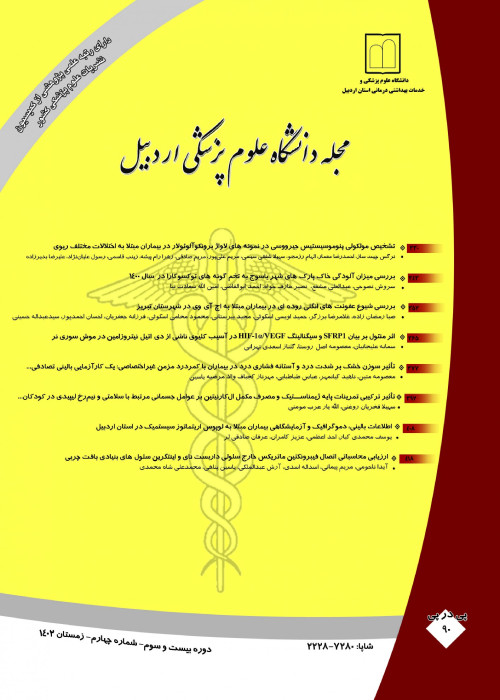Clinical and Epidemiological Characteristics of Patients with HIV in Ardabil City during 2005-2014
Author(s):
Abstract:
Background and Objectives
Human immunodeficiency virus (HIV) is a globally widespread infection that spreads mainly through sexual contact, mother to child and intravenous drug use. The disease can vary from an asymptomatic state to advanced immune deficiency and AIDS-related opportunistic infections and complications. Patients may be diagnosed at different stages of the disease. In this study, we aimed to analyze the clinical and epidemiological characteristics of patients with HIV and its consequences during the past 10 years (2005-2014) in Ardabil city.Methods
In this descriptive and case series study, patients with HIV (including live and dead patients) referring to the Ardabil behavioral counseling center were included during 2005-2014 years. The checklist containing demographic data, modes of transmission, time of diagnosis, clinical and therapeutic problems during this period, etc. was prepared for each patient. In dead patients, the causes of death as well as the interval between diagnosis and death were investigated.Results
In this study, 60 patients with HIV were evaluated, the mean age was 42.96 years, 76.7% of patients were male and 48.2% were intravenous drug users. In 39.7% of cases, patients have probably been infected through intravenous injection and 33.3% by sexual contact. The mean CD4 lymphocyte cell count of patients was 252 cells per ml. The most common early symptoms of the disease were fever (63.33%), aphthous stomatitis (35%) and diarrhea (28.33%). In 7 cases (50%), tuberculosis was the most common opportunistic infection. 6 patients (10%) had coinfection with hepatitis B or C. 28 patients (46.6%) died within the time of study. The median time from diagnosis to death was 44.84±39.65 months and cardiorespiratory failure was the most common cause of death among patients.Conclusion
This study showed that most patients were middle-aged and intravenous drug use was the most common risk factors for HIV. The most common way of transmission was intravenous injection and hepatitis C and tuberculosis were the most important comorbidities, respectively. Raising community awareness about the disease, early diagnosis and appropriate care during illness are basic measures to deal with this global problem. Keywords:
Language:
Persian
Published:
Journal of Ardabil University of Medical Sciences, Volume:17 Issue: 64, 2017
Pages:
221 to 229
magiran.com/p1724217
دانلود و مطالعه متن این مقاله با یکی از روشهای زیر امکان پذیر است:
اشتراک شخصی
با عضویت و پرداخت آنلاین حق اشتراک یکساله به مبلغ 1,390,000ريال میتوانید 70 عنوان مطلب دانلود کنید!
اشتراک سازمانی
به کتابخانه دانشگاه یا محل کار خود پیشنهاد کنید تا اشتراک سازمانی این پایگاه را برای دسترسی نامحدود همه کاربران به متن مطالب تهیه نمایند!
توجه!
- حق عضویت دریافتی صرف حمایت از نشریات عضو و نگهداری، تکمیل و توسعه مگیران میشود.
- پرداخت حق اشتراک و دانلود مقالات اجازه بازنشر آن در سایر رسانههای چاپی و دیجیتال را به کاربر نمیدهد.
In order to view content subscription is required
Personal subscription
Subscribe magiran.com for 70 € euros via PayPal and download 70 articles during a year.
Organization subscription
Please contact us to subscribe your university or library for unlimited access!


